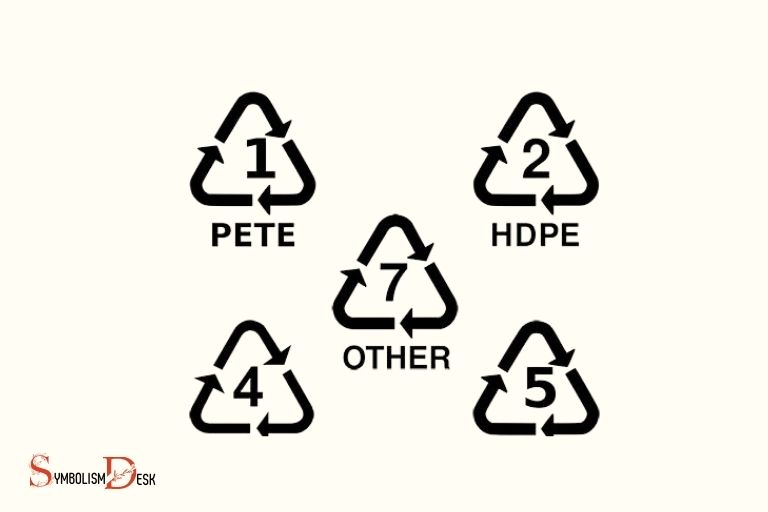What Does the Recycle Symbol Mean on Plastic Bottles?
The recycle symbol on plastic bottles, often represented by three arrows forming a triangle, simply signifies that the plastic material used in making the bottle is recyclable.
However, it does not guarantee that the bottle will be accepted by all recycling facilities since the recycling process varies based on the type of plastic resin the bottle is made of.
The recycle symbol indicates that the plastic bottle is made from recyclable materials that can be processed and repurposed into new items.
On many plastic bottles, you’ll notice a number inside the recycle symbol. This number, ranging from 1 to 7, signifies the type of plastic resin used in the bottle’s manufacturing process. This coding system helps consumers and recycling facilities properly sort and process the plastic bottles, ensuring they are recycled in the most effective and environmentally friendly manner. For example, PETE (Polyethylene Terephthalate) is represented by the number 1, while HDPE (High-Density Polyethylene) is represented by the number 2. It is important to pay attention to these numbers and the green dot recycling symbol explained to ensure that plastic bottles are disposed of and recycled properly.
Different recycling facilities have different capabilities and may only accept specific types of plastic.
Understanding the recycle symbol and what it represents is essential in aiding the recycling process.
By being aware of the type of plastic we use and discard, we can make informed choices and contribute positively to the recycling process.
This will ultimately lead to a more sustainable and environmentally friendly society.
7 Recycling Symbols on Plastic Bottles Meanings
| Recycling Symbol | Plastic Resin Type | Description and Common Uses |
|---|---|---|
| Number 1 | PET (Polyethylene Terephthalate) | PET bottles are commonly used for water, soda, and juice. They are highly recyclable and can be turned into new bottles or polyester fibers for clothing. |
| Number 2 | HDPE (High-Density Polyethylene) | HDPE bottles are used for milk, detergent, and shampoo. They are recyclable and often transformed into plastic lumber, pipes, and containers. |
| Number 3 | PVC (Polyvinyl Chloride) | PVC is less commonly used for bottles due to concerns about chemicals. It’s used in pipes, vinyl flooring, and credit cards. Recycling PVC can be challenging. |
| Number 4 | LDPE (Low-Density Polyethylene) | LDPE is found in squeeze bottles, plastic bags, and some food containers. It can be recycled into new plastic bags and certain plastic products. |
| Number 5 | PP (Polypropylene) | PP is used for yogurt cups, bottle caps, and some food containers. It’s recyclable and can be turned into various plastic items. |
| Number 6 | PS (Polystyrene) | PS is used for disposable cups, plates, and packaging. It’s not as widely accepted for recycling and may end up in landfills. |
| Number 7 | Other Plastics | This category includes various plastics like polycarbonate and bioplastics. Recycling options can vary, so check local guidelines. |
Key Takeaway

Five Facts About: The Recycle Symbols on Plastic Bottles
Which Type Of Plastic Can Be Recycled?
Explanation Of Different Plastic Types And Their Identification Codes
Plastic containers are everywhere, from bottles to food packaging and beyond. Understanding the type of plastic is essential to know if it can be recycled, as well as how to recycle it properly.
Each plastic product has a distinct code on its base that helps identify its type.
Below are the identification codes for the seven most commonly used types of plastic:
- Polyethylene terephthalate (pet or pete): This plastic is easy to recycle and is commonly used for water and soda bottles, salad dressing, and peanut butter jars.
- High-density polyethylene (hdpe): Hdpe is heat-resistant, sturdy, and mainly used for milk jugs, shampoo bottles, and laundry detergent.
- Polyvinyl chloride (pvc): Pvc is utilized for window frames, pipes, and medical tubes.
- Low-density polyethylene (ldpe): Ldpe is soft and flexible and often used for plastic bags, dry cleaning bags, and bread bags.
- Polypropylene (pp): Pp is a durable plastic; commonly used for containers such as yogurt and margarine containers, as well as medicine bottles.
- Polystyrene (ps): Ps is inexpensive and widespread in fast-food containers and packaging peanuts.
- Miscellaneous types (other): This category includes compostable materials and bioplastics.
Detail On Which Types Of Plastic Are Recyclable
Not all plastics are recyclable. While some are widely recycled, others have stringent limitations on how they can be recycled.
Here are the recycling capabilities of the seven most common plastic types:
- Pet/pete: This plastic type is widely accepted for recycling.
- Hdpe: This plastic is recyclable almost everywhere in the world.
- Pvc: Pvc is not recyclable due to its harmful chemicals when melted.
- Ldpe: This category is not accepted for community recycling but may be recycled through return-to-retailer programs.
- Pp: This plastic type is usually accepted in recycling programs.
- Ps: Not all community recycling programs accept this type of plastic.
- Other: While some compostable materials and bioplastics are marketed as eco-friendly, they require specific conditions to break down and may not be accepted in recycling programs.
Explanation Of The Difference Between Biodegradable And Compostable Plastics
Compostable and biodegradable plastics are becoming increasingly popular among consumers and businesses.
However, these terms can be confusing, with many people thinking that they mean the same thing. Here’s the lowdown:
Biodegradable plastics are made from plant-based materials, petroleum, or a combination of both and will break down naturally over time.
They decompose through microbial activities; however, they may release harmful chemicals into the environment during this process.
Compostable plastics are plant-based products that degrade into natural organic matter, carbon dioxide, and water.
They require specific conditions like heat, humidity, and microorganisms to decompose properly and cannot break down in landfills.
It’s vital to dispose of compostable and biodegradable plastics responsibly to avoid environmental damage.
When in doubt, always check your local recycling program rules to know what can and can’t be recycled.
The Meaning Of The Recycle Symbol
Importance Of The Recycle Symbol On Plastic Bottles
When it comes to recycling, one of the most critical aspects to consider is understanding the various recycling symbols on plastic bottles.
These symbols are not merely cute designs on the packaging, but they contain essential information regarding the recycling of bottles, which can significantly impact the environment.
Here are some reasons why the recycle symbol is crucial:
- The symbol helps inform consumers about the material used for the packaging of a product.
- It encourages individuals to recycle and dispose of waste appropriately.
- Recycling the materials from plastic bottles can significantly reduce waste and pollution, thereby conserving natural resources.
Explanation Of The Three-Arrow Triangular Symbol
The recycle symbol is made up of three arrows, forming a triangle, and is easily recognizable on plastic bottles and other products.
The triangular symbol is a universally accepted sign for recycling, with each arrow representing a particular aspect of the recycling process.
This is what each arrow signifies:
- The first arrow signifies the collection of materials to be recycled.
- The second arrow represents the process of turning the collected materials into a new product.
- The third arrow implies the purchase of recycled products by the consumers, completing the recycling loop.
Discussion On The Numbers Inside The Symbol
Inside the triangular symbol, you will notice a number from 1 to 7, which helps with identifying the type of plastic used in the packaging.
Knowing the type of plastic is vital because not all plastics can be recycled.
Here is a breakdown of what each number means:
- Pet or pete (polyethylene terephthalate)
- Hdpe (high-density polyethylene)
- Pvc (polyvinyl chloride)
- Ldpe (low-density polyethylene)
- Pp (polypropylene)
- Ps (polystyrene)
- Other types of plastic
Knowing the type of plastic used in a product is also useful for manufacturers as it helps them create packaging that is recyclable.
Therefore, the display of the recycle symbol and the accurate identification of the type of plastic used is essential for effective recycling.
The recycle symbol is more than just a symbol; it’s a system that encourages responsible consumption, recycling, and resource conservation.
By understanding the information relayed by the recycling symbol, individuals can improve their recycling habits and make an essential contribution to environmental sustainability.
The Recycling Process For Plastic Bottles
What does the recycle symbol mean on plastic bottles: The recycling process for plastic bottles
Plastic bottle waste is a major environmental issue that can take hundreds of years to decompose. The good news is that plastic bottles can be recycled, reducing landfill waste and conserving natural resources.
In this section, we’ll dive into the recycling process for plastic bottles, including the sorting and cleaning process, as well as how the recycled materials are repurposed.
Overview Of The Recycling Process For Plastic Bottles
The recycling process for plastic bottles can vary depending on the facilities and the type of plastic.
Here is a high-level overview of the typical recycling process:
- Collection: Plastic bottles are collected through curbside pickup programs, drop-off centers, or recycling centers.
- Sorting: Bottles are sorted based on their type, color, and shape. Machines scan and separate the bottles using optical sensors and air jets.
- Cleaning: Bottles are cleaned to remove any impurities or leftover contents. Labels and bottle caps are also removed.
- Shredding: Shredders chop the bottles into smaller flakes.
- Melting: Heat is applied to the flakes, melting them down into a liquid.
- Reforming: The melted plastic is molded into new products, such as plastic lumber, textiles, and automotive parts.
Explanation Of The Sorting And Cleaning Process
The sorting and cleaning process is crucial to ensure the quality of the recycled plastic.
Here are the key steps involved:
- Optical sensors scan the bottles as they are transported on a conveyor belt, identifying the type, color, and shape of each bottle.
- Air jets blast the bottles into different streams based on their characteristics.
- Labels and bottle caps are removed using blowers and sieves.
- Bottle flakes are washed and rinsed multiple times to remove any impurities or contaminants, such as dirt, oil, and food residue.
Discussion On How The Recycled Materials Are Repurposed
Recycled plastic bottles can be turned into a wide range of new products, from clothing to furniture.
Here are some examples of how the recycled materials are repurposed:
- Plastic lumber: Made from shredded plastic bottles, plastic lumber is durable, lightweight, and resistant to rotting, insects, and uv rays. It can be used to make outdoor decking, fencing, and garden furniture.
- Textiles: Recycled plastic bottles can be crushed into tiny fibers and spun into polyester yarn. This yarn can be used to make a variety of clothing and accessories, such as t-shirts, jackets, and backpacks.
- Automotive parts: Car manufacturers use recycled plastic bottles to make parts such as bumpers, dashboards, and door panels.
- Bottles: Yes, you read that right. Some recycled plastic bottles are turned into, you guessed it, new plastic bottles.
Recycling plastic bottles is a crucial step in reducing waste and protecting the planet.
By understanding the recycling process, we can make informed decisions about our consumption habits and properly dispose of plastic bottles.
Remember to always look for the recycle symbol on plastic bottles and do your part in keeping our planet clean and healthy.
What Does Recycle Symbol 4 Mean on LDPE Plastic Bottles?
Recycle symbol 4 meaning: ldpe revealed. The presence of recycle symbol 4 on LDPE plastic bottles signifies that they are made from low-density polyethylene. LDPE is a widely used plastic known for its flexibility, strength, and recyclability. This symbol indicates that these bottles can be recycled and should be sorted accordingly to minimize environmental impact.
FAQ About What Does The Recycle Symbol Mean On Plastic Bottles
What Does The Recycling Symbol On Plastic Mean?
The recycling symbol on plastic indicates the type of plastic used in the product and helps facilitate its recycling.
What Do The Numbers Inside The Recycling Symbol Mean?
The numbers inside the recycling symbol on plastic are resin identification codes that identify the type of plastic used.
What Type Of Plastics Are Commonly Recycled?
Commonly recycled plastics include pete, hdpe, pvc, ldpe, pp, and ps. Check your local recycling guidelines for specifics.
Can All Plastics Be Recycled?
No. Some plastics cannot be recycled due to their chemical composition, shape, or contamination. Check your local recycling guidelines for specifics.
How Can I Recycle My Plastic Bottles Properly?
To recycle plastic bottles properly, empty their contents, rinse them with water, and place them in a recycling bin. Check with your local recycling program if caps are acceptable.
Conclusion
Overall, the recycling symbol can tell you a lot about the plastic bottle you are using.
It can indicate the plastic resin code, which can give you insight into the material’s properties and characteristics.
Additionally, it can help you identify whether the bottle is recyclable and how it should be disposed of properly.
Understanding these symbols can help you make better decisions about the plastic bottles you use and ultimately reduce your environmental impact.
It is important to remember that recycling is just one part of the solution to our plastic waste problem.
It is important to reduce our overall consumption of single-use plastics and look for more sustainable alternatives wherever possible.
With greater awareness and action, we can all work towards a more sustainable future.






